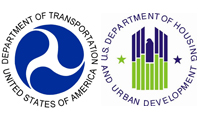
Smart Growth bills advance in New York StateSome important bills have been rapidly moving forward in New York State in the past few weeks, many of which are part of the Long Island Lobby Day Coalition's legislative package. In many instances, we have been told that these bills have moved forward in large part due to pressure and advocacy work on behalf of Long Island and the Coalition. It's exciting to see so many good things getting done at the state level!
The Smart Growth Public Infrastructure Policy Act passed the Assembly and Senate last week and is currently awaiting the Governor's signature, which is expected to take place soon. Among the first to hear the news were 600 attendees of the 2010 Smart Growth Awards last Friday. Senator Brian X. Foley, a sponsor of the bill, called in to the event with the hot-off-the-Senate-floor news that the bill had passed overwhelmingly. We thank all the Legislators who listened to their constituents and helped pass this vital bill, and we encourage Governor Paterson to sign it into law. The bill amends the environmental conservation law "to provide for state funding of infrastructure in a manner that is consistent with smart growth principles." It favors "fix-it-first" projects and authorizes each State infrastructure agency to create a Smart Growth advisory committee. This bill is a big win for Smart Growth, essentially disallowing municipal agencies from subsidizing sprawl. The bill language is available here (Senate) and here (Assembly).
The Complete Streets bill passed the Senate last Thursday by a 58-3 margin. Vision's Eric Alexander traveled to Albany last Thursday for a press conference sponsored by Senate Transportation Committee Chair Martin Malavé Dilan to announce the Senate's passage and to encourage the legislation to move forward quickly. A video of the press conference is available here; skip to 24:45 for Vision's part. A version of the bill passed through the Assembly Transportation Committee last week with several amendments that make the bill quite different from the Senate version; both houses will have to work out the differences. The LI Lobby Day Coalition encourages the Assembly to adopt the Senate bill's language in order for a successful bill to pass before this legislative session expires. According to an analysis by Tri-State Transportation Campaign: "The differences are quite stark. The Assembly bill would affect only state roads (the Senate affects state, county, and local roads receiving state or federal funds), add unnecessary exemptions, and generally weaken the legislation so it is more a requirement to study complete streets measures instead of actually implementing them." The bill amends the State Highway law, enabling safe access to public roads for all users by utilizing Complete Streets design principles. Complete Streets is a policy that ensures all users of the transportation system, including pedestrians, bicyclists, transit users, motorists, children, seniors and individuals with disabilities are able to travel safely and conveniently on and across all roads. The Senate's bill language is available here. The following is a joint statement on the status of the Complete Streets bill by several advocacy organizations, including Vision. Please urge your Assembly members to pass a Complete Streets bill using the Senate bill's language!
Universal Design passed the Senate and was referred to Assembly two weeks ago. The bill "establishes the universal design incentive which authorizes the secretary of the department of state to reduce building permit fees for new construction or substantial alterations providing for accessible housing for persons with physical disabilities." In other words, the bill incentivizes homes to be built using universal design principles which allow elderly or disabled persons to live comfortably in their homes; or to "age in place." Senator Brian X. Foley sponsored the bill, available here. The following are statements in support of this legislative package from Senators and LI Lobby Day Coalition members:
US DOT and HUD launch collaborative funding effort to create livable, sustainable communities
Earlier this week, US Transportation Secretary Ray LaHood and US Housing and Urban Development Secretary Shaun Donovan announced a groundbreaking collaborative effort designed to help foster planning for more livable, sustainable communities– places where transportation, housing and commercial development investments are coordinated to better serve the people living in those communities. For the first time, the DOT and HUD will join forces to award up to $75 million in funding for localized planning activities that ultimately lead to projects that integrate transportation, housing and economic development. Of those funds, $35 million will be TIGER (Transportation Investment Generating Economic Recovery) II Planning Grants and $40 million will be Sustainable Community Challenge Grants. TIGER II Planning Grants may be used to plan, prepare or design surface transportation projects that would be eligible for funding under the TIGER II Discretionary Grant program. These projects include highways, bridges, transit, railways, ports or bicycle and pedestrian facilities. HUD’s Sustainable Communities funding will target urban and community planning projects that foster reform and reduce barriers to achieving affordable, economically vital and sustainable communities. Such efforts may include amending or replacing local master plans, zoning codes and building codes either on a jurisdiction-wide basis or in a specific neighborhood or sector to promote mixed-use development, affordable housing and the re-use of older buildings for new purposes with the goal of promoting sustainability at the local level. These activities, when done in conjunction with transportation projects, can greatly increase the efficiency and effectiveness local transportation, and access to it, while encouraging mixed-use or transit-oriented development. The program will encourage and reward areas that are planning more innovative projects that coordinate housing, economic development and transportation investments. This new program builds on the Partnership for Sustainable Communities, an innovative new interagency collaboration, launched by President Obama in June 2009, between the DOT, HUD and the Environmental Protection Agency (EPA). Guided by six Livability Principles, the Partnership is designed to remove the traditional federal government silos that exist between departments and strategically target the agencies’ transportation, land use, environmental, housing and community development resources to provide communities the resources they need to build more livable, sustainable communities. The Partnership will be coming to Long Island this summer to help boost downtowns by cutting through some of the existing red tape in the planning process. The meeting is coming together with the help of Senator Charles Schumer, Vision Long Island, Sustainable Long Island and the National Center for Suburban Studies at Hofstra University. Learn more and apply for a grant here. Pre-applications are due on July 26th. You can also read more here about the grants here. |
SMART GROWTH NEWS Newsletter Editor: Michelle Dutchen, Director of Communications We strive to provide continued quality publications such as this each week. If you have any news or events that you would like to add to our newsletter, submit them to info@visionlongisland.org for consideration. If you are interested in becoming a newsletter or news blast sponsor, please call the office at 631-261-0242 for rates and opportunities. For more information about Vision Long Island, visit visionlongisland.org or contact us at: |

.jpg)

